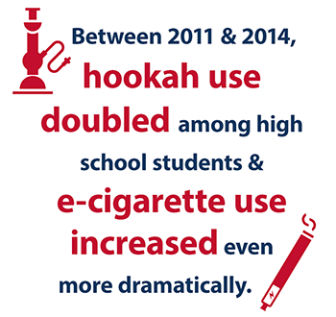Kids and Tobacco Use: Some Surprising Findings
On this page:
The number of kids smoking cigarettes is down—but the number using other tobacco products is way up. That’s the word from the 2014 National Youth Tobacco Survey (NYTS), co-conducted by the Centers for Disease Control and Prevention (CDC) and the Food and Drug Administration (FDA).
“This is the only nationally representative survey of middle and high school students that focuses exclusively on tobacco use,” says Benjamin J. Apelberg, Ph.D., branch chief of epidemiology at FDA’s Center for Tobacco Products.
Survey results provided a national snapshot of what tobacco products today’s middle and high school youth are using, as well as emerging trends over time.
The key findings include:
- In 2014, one in four high school students and one in 13 middle school students reported being tobacco users (using one or more tobacco products in the previous 30 days).
- Of the then-current 4.6 million youth tobacco users, 2.4 million reported using e-cigarettes.
- Between 2011 and 2014, the percentage of students reporting current use of cigarettes decreased from 15.8% to 9.2%.
- Between 2011 and 2014, hookah use among high school students doubled and e-cigarette use increased even more dramatically.
- In 2014, nearly 2.2 million students reported using two or more tobacco products.
Since the survey started collecting data on e-cigarettes in 2011, in 2014 their current use for the first time surpassed current use of every other tobacco product, including conventional cigarettes.
“One thing the study confirms for us is that the tobacco product landscape has changed dramatically,” Apelberg says. “Middle and high school kids are using novel products like e-cigarettes and hookahs in unprecedented numbers, and many are using more than one kind of tobacco product.”
It’s something of a good news/bad news picture, says FDA epidemiologist Catherine Corey. “While we’re glad to see cigarette smoking decreasing in middle and high school youth, the increase in the use of e-cigarettes and hookahs undermines progress in reducing tobacco use among kids,” she says.
Nicotine Can Affect the Developing Brain
Nicotine is dangerous and highly addictive for kids at any age, whether it comes from an e-cigarette, hookah, cigarette or cigar. Because the brain is still developing, adolescence appears to be a particularly vulnerable time. Research has clearly demonstrated that exposure to nicotine at a young age increases the chance that kids will become addicted. In addition to nicotine exposure, tobacco use can be harmful due to the numerous other chemicals present in tobacco products that can cause disease.
“Youth should not use tobacco in any form,” Apelberg says.
At this time, FDA has regulatory authority over cigarettes, cigarette tobacco, roll-your-own tobacco and smokeless tobacco. The agency is in the process of finalizing a rule that would extend its authority to regulate additional products that meet the legal definition of a tobacco product, such as electronic cigarettes, cigars and hookahs. FDA is also proposing a minimum age of 18 for buying tobacco.
“These latest findings serve to strengthen existing scientific evidence that novel tobacco products like e-cigarettes and hookah have great appeal to youth, and that comprehensive youth prevention efforts that focus on reducing all forms of tobacco use are needed,” says Corey.
Results of the survey were published in the Morbidity and Mortality Weekly Report in April, 2015.
How You Can Help
FDA’s tobacco compliance and enforcement efforts range from training and education to monitoring compliance with the law and initiating advisory and enforcement actions. In addition, the agency inspects tobacco retailers to ensure, among other things, that retailers are checking IDs and not selling regulated tobacco products to anyone under the age of 18.
8p>June 19, 2018Return to FDA Consumer Articles

